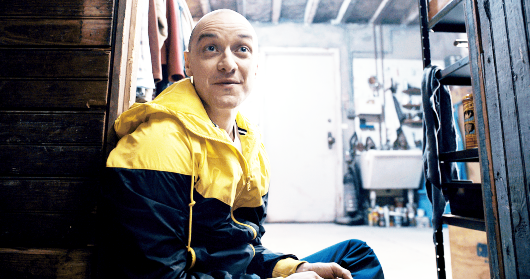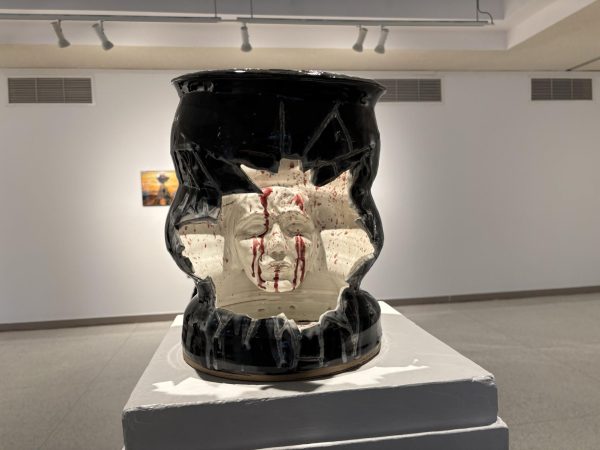Shyamalan finds balance in “Split”

Contributed by geeksofdoom.com
James McAvoy plays Kevin—a man with 24 personalities—in Manoj “M. Night” Shyamalan’s latest horror-thriller, “Split,” released on Jan. 20, 2017.
After seeing Manoj “M. Night” Shyamalan’s latest movie, “Split,” you might wonder why he had not made a movie like this earlier in his career. “Split” is not a great movie, but it is good enough, and it feels like a natural extension of the vision established by Shyamalan’s earlier movies.
Before seeing “Split,” you might wonder why Shyamalan keeps getting payrolled considering the number of failures he’s released—“The Happening,” “The Last Airbender” and “After Earth.” Last year, he had a small success with “The Visit,” but prior to that, his movies had been dreadful, and not the kind of dreadful that allows for financial success. They have either been bad wannabe blockbusters or bad personal projects. None of Shyamalan’s later work feels like it has a balance between a commercially viable perspective and an inspired artistic voice. They are works of lazy concession or pure pretension.
“Split,” a horror-thriller starring James McAvoy as Kevin, a man with 23 personalities who abducts three teenage girls, changes that. Shyamalan owes a lot of the credit to McAvoy, who turns the idea of a psychopath with multiple personalities from a trope to a showcase of his talent as an actor. Particularly early in the movie, McAvoy’s shift from personality to personality offers an exhilarating sense of surprise.
Shyamalan projects typically use twists as a cheap way to introduce surprise at the end of movies that otherwise seem only interested in creating an eerie aesthetic. Here though, there is a better sense of balance between the movie’s visual aspirations and the need to deliver a compelling plot. Ultimately, there is a sense that we know where the story is going, but McAvoy’s performance makes watching that process compelling. I will not say whether there is a signature Shyamalan twist, but I did not spend the entire run time anticipating one, because it did not feel reliant on a last-minute shock grab.
Calling “Split” a return to form for Shyamalan does not quite lead on how much this movie feels embedded in current movie tropes. The movie plays with an idea—here advanced by Kevin’s therapist—that he is able to unlock more of the human brain’s potential through his ability to switch personalities. Not only does his mental state change when he switches personalities, his physical state does as well, making him more remarkable than other people. The pseudo-neuroscience makes “Split” resemble action movies like “Limitless” and “Lucy” while the way psychology is integrated into horror make it feel akin to art-house movies like “The Babadook” and “Goodnight Mommy.”
Shyamalan is not being particularly original here, and again I feel the need to point out that it is largely McAvoy that makes this film feel fresh. I will say that the movie’s approach to the psychology behind its characters rarely feels as exploitative as it could. “Spilt” decides to use child abuse—sexual abuse in particular—as motivations for McAvoy’s character as well as the female lead, played by Anya Taylor-Joy. Oddly enough, something similar happens in “Fantastic Beasts and Where to Find Them.”
The results of abuse shown in “Fantastic Beasts” make the abused feel like a caricature—simply downtrodden, ugly and sad. Furthermore, the movie never had the negative capability to make the audience truly commiserate with that kind of pain. It was too busy appealing to as wide of an audience as possible.
“Split” is still a genre movie, but the extremity of Kevin’s dissociative disorder doubles as extreme effects of abuse. Cruelty does not render him incompetent, but it does make the process of Kevin expressing himself agonized and fractured. Taylor-Joy’s character struggles because of her past abuse as well, but what she went through, the movie suggests, has made her extraordinarily equipped to handle Kevin. Of course, “Split’s” idea that the adversity of abuse can make people more extraordinary—just in horrible ways a simplification in its own right. For me though, it is a simplification that is in service of an effort to convey actual pain.
“The Babadook” is a good reference point for “Split’s” final third, because like that movie, “Split” decides to conflate psychological horror with scary monster horror. I have mixed feelings about how that forces their endings. The two movies are not ruined in either case, but in both the need for psychological clarity and the need for action undercut one another. The sense of inevitability gets exhausting. You will know what has been coming for a while and feel like you have seen it before. Shyamalan has done enough up to that point that—for him especially—predictability does not seem like such a bad outcome.







